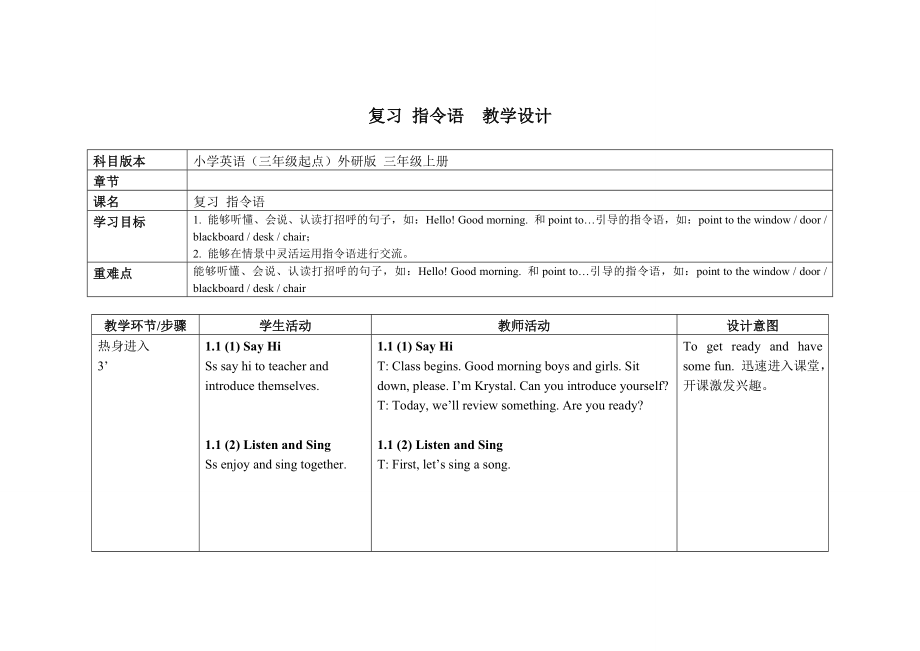《三年級(jí)上冊(cè)英語(yǔ)教案 復(fù)習(xí) 指令語(yǔ)外研社(三起)》由會(huì)員分享����,可在線閱讀,更多相關(guān)《三年級(jí)上冊(cè)英語(yǔ)教案 復(fù)習(xí) 指令語(yǔ)外研社(三起)(4頁(yè)珍藏版)》請(qǐng)?jiān)谘b配圖網(wǎng)上搜索�����。
1�����、復(fù)習(xí) 指令語(yǔ) 教學(xué)設(shè)計(jì)
科目版本
小學(xué)英語(yǔ)(三年級(jí)起點(diǎn))外研版 三年級(jí)上冊(cè)
章節(jié)
課名
復(fù)習(xí) 指令語(yǔ)
學(xué)習(xí)目標(biāo)
1. 能夠聽(tīng)懂����、會(huì)說(shuō)�����、認(rèn)讀打招呼的句子�����,如:Hello! Good morning. 和point to…引導(dǎo)的指令語(yǔ)�,如:point to the window / door / blackboard / desk / chair�����;
2. 能夠在情景中靈活運(yùn)用指令語(yǔ)進(jìn)行交流���。
重難點(diǎn)
能夠聽(tīng)懂、會(huì)說(shuō)���、認(rèn)讀打招呼的句子�,如:Hello! Good morning. 和point to…引導(dǎo)的指令語(yǔ)����,如:point to the window / door
2、 / blackboard / desk / chair
教學(xué)環(huán)節(jié)/步驟
學(xué)生活動(dòng)
教師活動(dòng)
設(shè)計(jì)意圖
熱身進(jìn)入
3’
1.1 (1) Say Hi
Ss say hi to teacher and introduce themselves.
1.1 (2) Listen and Sing
Ss enjoy and sing together.
1.1 (1) Say Hi
T: Class begins. Good morning boys and girls. Sit down, please. I’m Krystal. Can y
3����、ou introduce yourself?
T: Today, we’ll review something. Are you ready?
1.1 (2) Listen and Sing
T: First, let’s sing a song.
To get ready and have some fun. 迅速進(jìn)入課堂,開課激發(fā)興趣���。
復(fù)習(xí)鞏固
12’
1.2 (1) Think and Say
? Ss look and say.
Ss: Sit down. / Stand up. / Hello! / Good morning! / Good after
4�、noon. / Good-bye. / door / window / blackboard / desk / chair.
1.2 (2) Look, Listen and Read
? Ss look, listen and read.
Ss: Sit down. / Stand up. / Hello! / Good morning! / Good afternoon. / Good-bye. / door / window / blackboard / desk / chair.
1.2 (3) Look and Say
? Ss: I can see a monke
5���、y. / It points.
? Ss: Point to a blackboard / chair / desk / door / window.
1.2 (4) Listen and Say
? Ss listen and follow.
? Ss chant again.
1.2 (5) Listen and Play
? Ss have a try.
1.2 (6) Say and Play
? Ss play the game in pairs.
1.2 (1) Think and Say
?T: Now, dear
6��、children, there are some beautiful pictures for you. Can you look and say?
1.2 (2) Look, Listen and Read
?T: Dear boys and girls, can you read the words or the phrases? Let’s try together.
1.2 (3) Look and Say
? T: Now, let’s have a rest. Let’s chant. First, let’s look at the
7��、 picture of the chant. It’s not a monkey, it’s a gorilla. It called Coco Gorilla. What else can you see in the picture? / What does the gorilla do?
? T: It points. So what can you say?
1.2 (4) Listen and Say
? T plays the video.
? T plays again.
1.2 (5) Listen and Play
? T: Now boys and
8�、 girls, let’s play a game. It called “Simon Says”.
? T shows the rules. T: If I say “Simon Says stand up”, you stand up. If I say “stand up”, but no “Simon Says”, you don’t do anything.
1.2 (6) Say and Play
? T: Now, it’s your turn. Please play the game in pairs.
To review 指令語(yǔ) and enhance
9、the ability of observing. 復(fù)習(xí)指令語(yǔ)的表達(dá)法����,并發(fā)展讀圖觀察能力。
To pretention to the forms of指令語(yǔ)�。復(fù)習(xí)有關(guān)指令語(yǔ)的語(yǔ)言結(jié)構(gòu),建立圖片與意義之間的聯(lián)系��。
To consolidate the structure and enhance the meaning of the structure.鞏固指令語(yǔ)的結(jié)構(gòu)��,加深對(duì)其表意功能的理解�����。
To make some fun. 通過(guò)聽(tīng)說(shuō)韻文加深對(duì)結(jié)構(gòu)功能的內(nèi)化并獲得樂(lè)趣�。
初步應(yīng)用
5’
1.3 (1) Lo
10、ok and Tell
? Ss: It’s in a classroom.
? Ss: Daming is coming.
? Ss: Daming says “Point to the chair / desk / blackboard / window / door.
1.3 (2) Summarize
1.3 (1) Look and Tell
? T: Our new friend Coco Gorilla comes into a room. Look, what place is it in? But, it isn’t a student,
11�、so he doesn’t know the things in the classroom.
? T shows Daming, T: who’s coming? This is Daming’s classroom. He lets Coco Gorilla know the classroom.
? T: Look at the action Coco does, can you guess, what does Daming say to Coco Gorilla?
1.3 (2) Summarize
? T: 親愛(ài)的同學(xué)們���,在這節(jié)課里我們復(fù)習(xí)了些什么內(nèi)容呢�����?是的�����,
12����、我們復(fù)習(xí)了打招呼和指認(rèn)物品�。我們可以邊指邊說(shuō)Point to…來(lái)引導(dǎo)其他人對(duì)這個(gè)事物的關(guān)注。希望同學(xué)們能運(yùn)用在日常生活中����。
To use the 指令語(yǔ) well. 通過(guò)游戲形式進(jìn)一步內(nèi)化和初步應(yīng)用指令語(yǔ)做事情。
Summarize the structure and the meaning. 總結(jié)本課所學(xué)�。
作業(yè)布置
Play the game “Simon Says” with friends.
進(jìn)步標(biāo)志
1. 能夠聽(tīng)懂、會(huì)說(shuō)���、認(rèn)讀打招呼的句子���,如Hello! Good morning. 和point to…引導(dǎo)的指令語(yǔ)���,如point to the window / door / blackboard / desk / chair;
2. 能夠在情景中靈活運(yùn)用指令語(yǔ)進(jìn)行交流�。
 三年級(jí)上冊(cè)英語(yǔ)教案 復(fù)習(xí) 指令語(yǔ)外研社(三起)
三年級(jí)上冊(cè)英語(yǔ)教案 復(fù)習(xí) 指令語(yǔ)外研社(三起)

